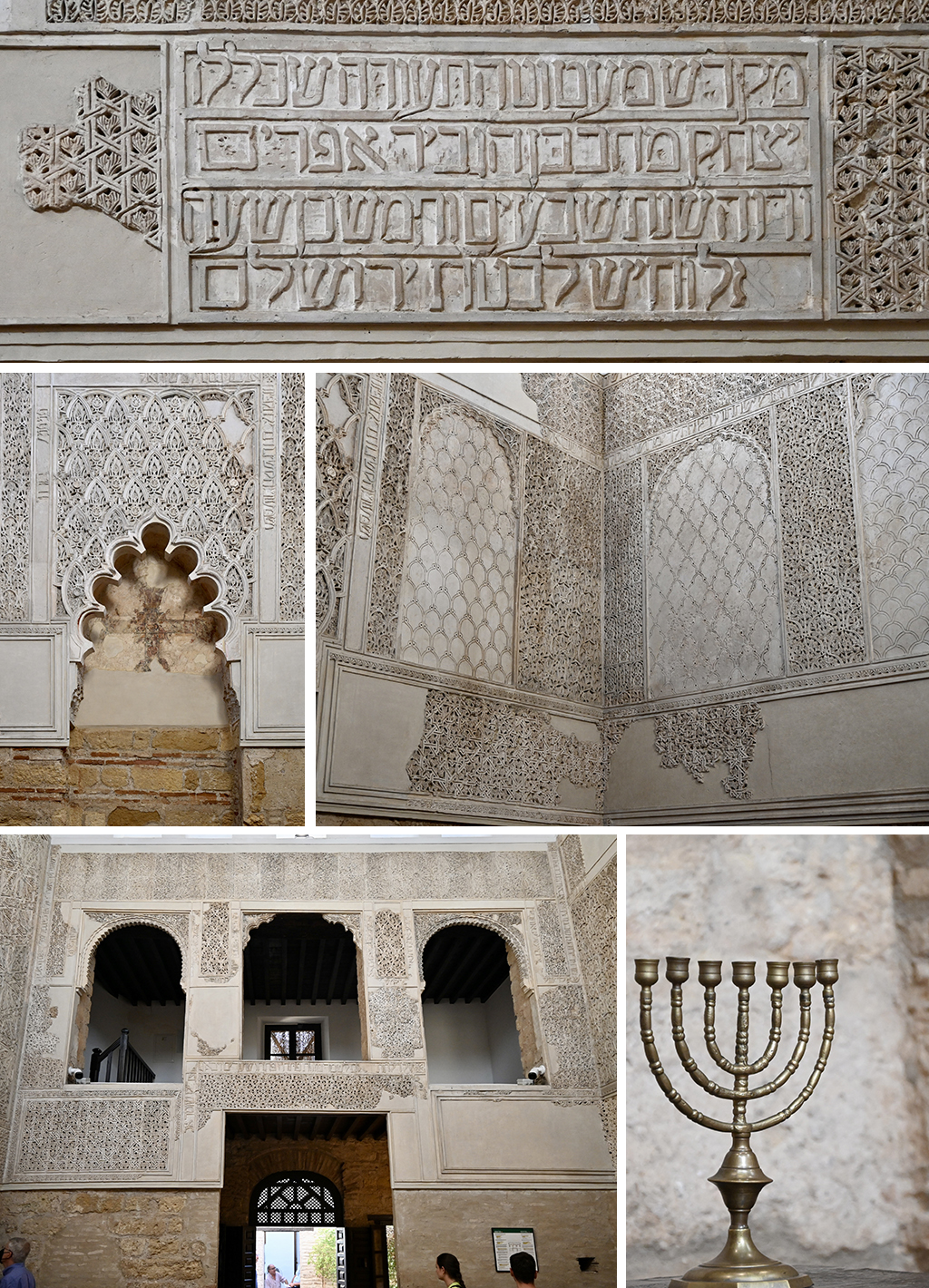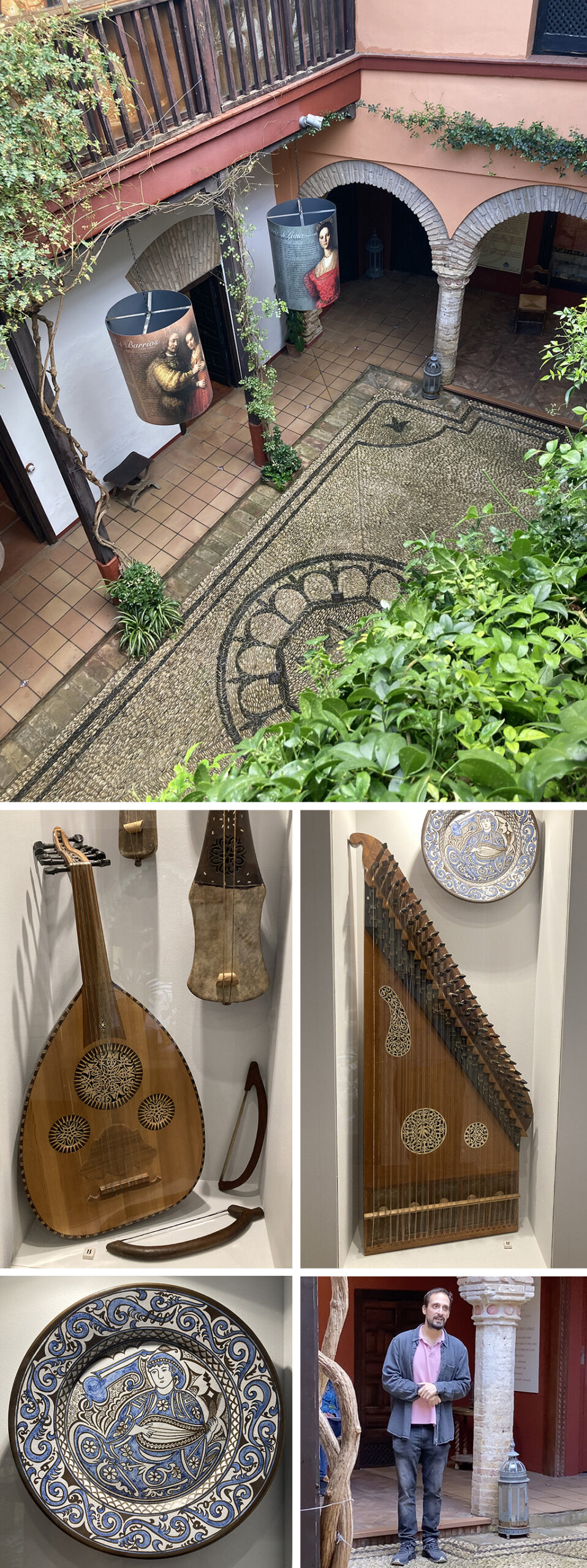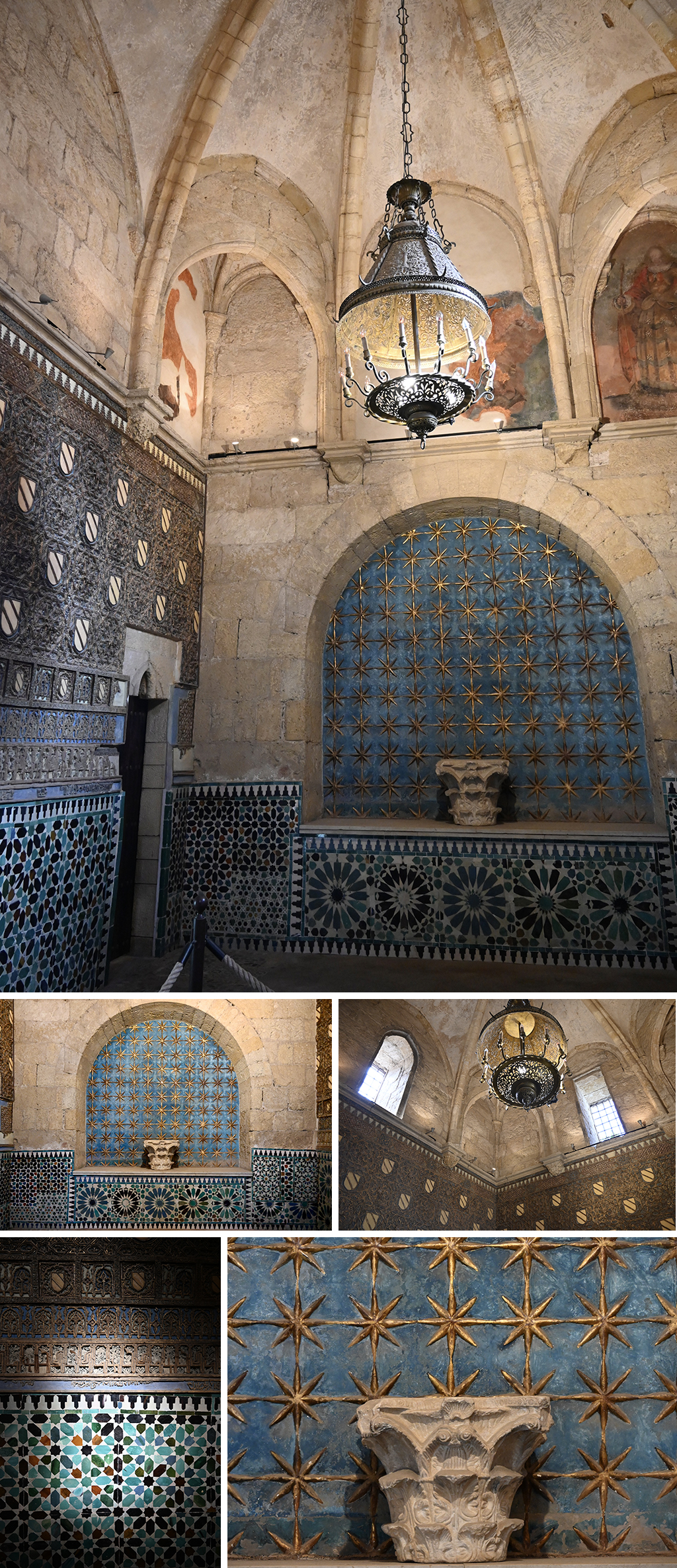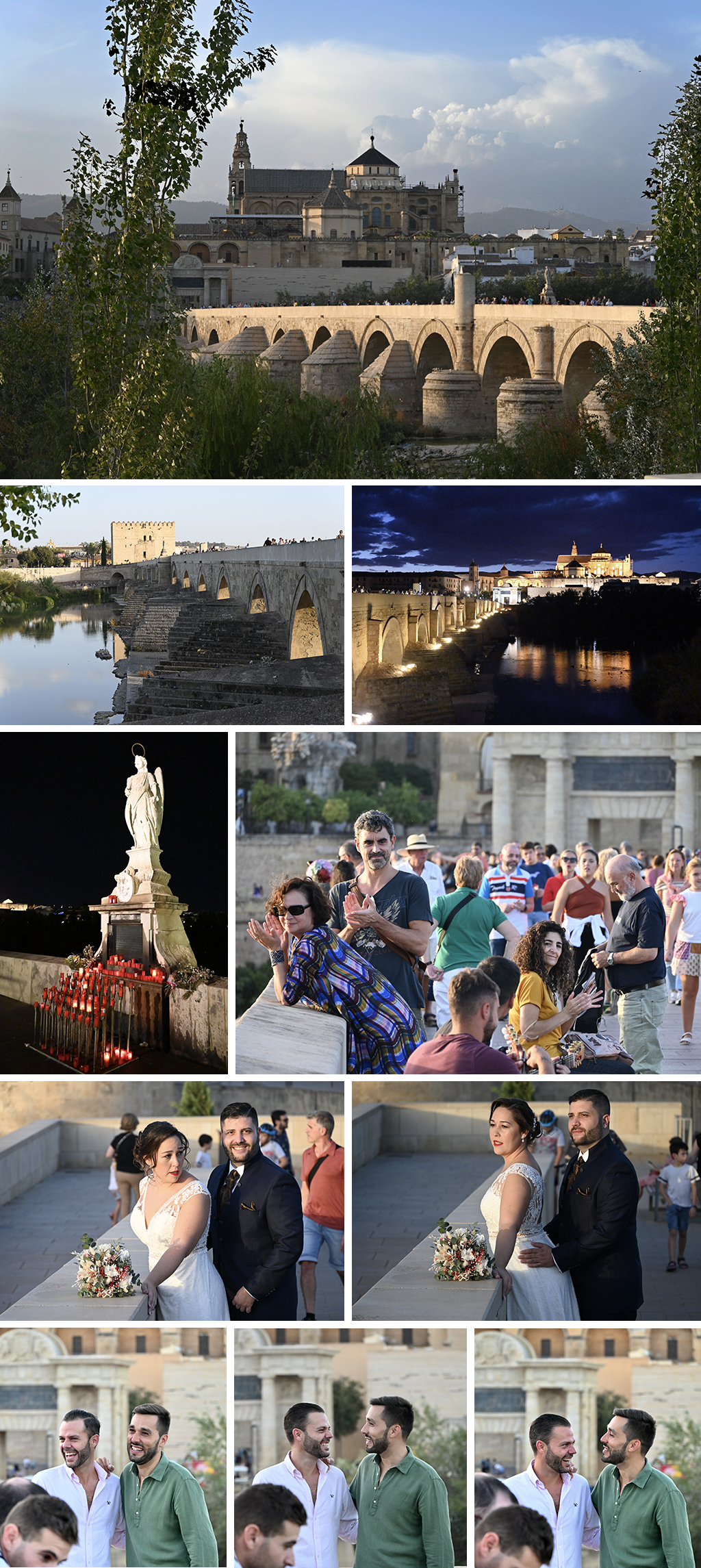

The apartment we rented in Córdoba was deep in a maze of narrow streets in a district known as La Judería, once the Jewish Quarter, which encompasses the mosque-cathedral, La Mezquita. Within that small section of town we found several places of interest, including the Synagogue, La Casa Andalusí, the Casa de Sefarad, the Capilla Mudéjar (Iglesia de San Bartolomé), and the Puente Romano. One thing we learned was that the prevailing medieval decorative style we today think of as “Arab”, had become the prevailing style, as was the Arabic language, and was used by people of all religions in Andalucía.
La Sinagoga de Córdoba

Built in 1315 in the Mudéjar style, this small building may have been the private synagogue of a wealthy merchant or possibly a yeshiva — a traditional Jewish school. It is one of only three synagogues that survive in Spain from that period; the other two are in Toledo.
From the courtyard, one enters through a low-ceilinged foyer into the prayer hall. The focus of this hall is a niche that once housed the ark of the Torah. The women’s gallery, once screened with a lattice, is above the foyer.
La Casa Andalusí

This house museum provides a glimpse into the home of a 12th-century Jewish merchant. It was fully restored in the late 1990s, and visitors are able to see the main floor. The house is built around a charming central patio. One room is dedicated to paper making, as Córdoba is reputed to be the place where the making of rag paper was introduced to Europe. Another room is beautifully furnished to represent the decorative style that prevailed at the time. The basement level has an interesting collection of farm implements, kitchen tools, archaeological fragments from the Visigoth era, and a freagment of a beautiful Roman mosaic. The house was flanked by additional narrow courtyards with fountains, one filled with roses petals and chrysanthemums.
Casa de Sefarad

Dedicated to Sephardic Jewish history of the Iberian Peninsula, this interesting museum comprises formal exhibits about their experience in Córdoba, including culture, language, literature, music, crafts, the Inquisition and subsequent Sephardic diaspora. It is very well done and parts of the narrative quite intense. We were fortunate to be there for a wonderful live performance by one of the docents in the courtyard of three traditional songs: one in Ladino (an old Castilian Spanish language mixed with Hebrew), one in Spanish, and one in a combination of Spanish, English, French, and Turkish. (Thanks to Markipedia for these photos of Casa de Sefarad.)
Capilla Mudéjar, Iglesia de San Bartolomé

Built in the late 14th century, this beautiful chapel is considered to be one of the finest examples of Mudéjar art to be found in Córdoba, another illustration of the broad adoption of this style across religious groups. Like the synagogue cited above, it includes only an entrance court, entry (in this case an open-air porch) and one large chapel room, and is quite beautiful and very much worth visiting.
Puente Romano

The Roman Bridge, sometimes known simply as the Old Bridge, crosses the Guadalquivir River going southeast from La Mezquita. The Romans built the basis of the surviving bridge in the 1st century BC. After some centuries of neglect in the Visigothic period, much it was rebuilt by Arabs in the 8th century, comprising most of what we see today. For centuries — up until the mid 1900s — it was the only bridge that crossed the river at Córdoba.
The bridge, now pedestrian only, is lively with street performers, shrines, lovers holding hands, and people carrying groceries home. It is also a perfect place, as you can see in the accompanying pictures, for engagement and wedding portraits. It is a pleasant place to stroll on a mild October day or warm evening.
Neighborhood Images

Walking around the Judería, we saw many beautiful and amazing sights and details.
Developed and maintained by Inspiratech LLC.
Design by Themeshift.
Susan Manfull
January 3, 2023 at 4:53 amGorgeous photos invite one to read the accompanying text which swoops the reader into those narrow passageways, secret courtyards, intricately carved decor, and stunning colors. What a treat!
Cocoa & Lavender
January 4, 2023 at 8:26 amI’m so glad you enjoyed the post, Susan! It is such and intriguing place.
Ronit
January 3, 2023 at 9:34 amThis post and beautiful photos are especially heart warming for me, as my ancestry is Sephardic on both sides.
The language you mentioned is called Ladino, and it is actually an old Castilian Spanish, with a few Hebrew words. It was kept as a way of easier communication between the Sephardic communities, once they were spread around the world.
I try to document some traditional Sephardic recipes in my blog, one of which was the homemade Marzipan I’ve used in the cake I’ve posted this week. More can be found under Sephardic in the search button. 🙂
Cocoa & Lavender
January 4, 2023 at 8:25 amI wish I had followed the link to your marzipan recipe. I would’ve learned a lot just from doing that! I have all the ingredients to make the marzipan, and plan to do so very soon. It’s the best recipe I have seen for it yet.
Mark and I both learned so much in our time spent in La Judería. And I learned more from your comment! I have updated the blog to mention your information about Ladino. Thanks so much.
Ronit
January 4, 2023 at 1:44 pmThank you David, for your compliment about the marzipan recipe. It’s a family treasure that I’m always glad to share.
Thanks for adding Ladino term to your post. It is somewhat sad, that by now it’s not used as much. On the other hand, this was due to the revival of Hebrew as a day-to-day language, rather than mostly used for religious practices, so there’s a positive aspect to that.
Another interesting fact is that the oldest synagogues in the US were built by Sephardic Jews. One of the most interesting ones is located in Newport RI. Others can be found in NYC, Philadelphia, and also in the South – New Orleans, Charleston and Savannah.
History is so fascinating. 🙂
Cocoa & Lavender
January 5, 2023 at 2:38 pmI just spent time reading through teh recipe — it’s definitely important to buy whole almonds and soak them. I agree that you get the best flavor. Do you want to know the thing that frightens me? The soft ball stage. I have never gotten that. But seeing your photo of the string of sugar between your thumb and forefinger really helps.
Having grown up in Philadelphia, and having lived in a predominantly Jewish neighborhood, I know the old one (now defunct) in North Philly — just googled to see other info. It dates back to 1784. Very cool. I wish the historic buildings had survived. The congregation is going strong, though! We are going to Charleston in April – I will definitely look up the Synagogue there. History IS fascinating!!
Ronit
January 5, 2023 at 7:23 pmI do understand the hesitation regarding soft ball stage. I’m very lucky, to have seen the process from an early age, so practicing it is quite natural for me. However, candy thermometer is always a good option.
In any case, even if you’ll miss the stage a bit, the worse that can happen is that the marzipan will get a bit grainier texture, rather than silky/smooth. But it would still be very tasty, and can be used in many ways. And by the second time time it’ll get much easier…
I visited another old Sephardic synagogue (dated 1740) in Philadelphia. in center city (4th st between Market and Arch), but it too is no longer in the original building. Still, it was an interesting visit.
Charleston was a lovely city when I visited almost 10 years ago, but so much has happened since… It would be interesting to read your posts from your future visit. 🙂
Jane Sanders
January 3, 2023 at 10:03 amThank you, David and Mark, for the wonderful tour of the Jewish Quarter. Growing up on Long Island, NY I had friends whose families were Sephardic Jews and they also had their own Synagogue in town. I loved their food much better than the Ashkenazi fare of my family. More fruits, nuts, lighter and healthier food……..
Cocoa & Lavender
January 4, 2023 at 8:22 amI also love Sephardic food, Jane. It is a really wonderful cuisine, though the Ashkenazi Jews also have some really good food as well. We learned a lot while there, and it’s quite sobering.
Jill Jill
January 3, 2023 at 12:01 pmStunning. Love this trip. Beautiful photos.
Cocoa & Lavender
January 4, 2023 at 8:21 amThanks for reading! xo
Mad Dog
January 3, 2023 at 12:18 pmStunning pictures of la Iglesia de San Bartolomé – the gold stars against the blue are particularly beautiful. If you are interested, there’s an even older synagogue in Barcelona, the Sinagoga Major de Barcelona, dating back to the 3rd or 4th Century. I took some pictures for a Jewish magazine in 1992 on the 500th aniversary of the expulsion in the Jews. At that time the building was used as a warehouse or storage space, but it has since been purchased and turned back into a synagogue/museum. Prior to the expulsion, the Jews had lived in Spain for at least twice as long as the Moors and Romans. In order to find enough money to leave, familes even sold their ancestors toombstones, many of these were used in the walls of Barcelona Cathedral …and some are still legible!
Cocoa & Lavender
January 4, 2023 at 8:21 amI that is really interesting, Mad Dog! We looked at lot Jewish history, and only found three ancient synagogues: one in Córdoba and two in Toledo. I will definitely check into the one in Barcelona. Yes, the stars on the blue are one of my favorite images from the entire trip. The church is just so beautiful.
Mad Dog
January 11, 2023 at 8:38 amThere’s also an extremely well preserved old Call (Jewish quarter), with synagogue/museum in Girona. The whole of the old city is exceptional 😉
Cocoa & Lavender
January 13, 2023 at 7:39 amSo much more to explore… I guess we will need to go back sooner than we thought!
Corbin
January 3, 2023 at 12:30 pmAnother in the wonderful ongoing travel experiences with David and Mark…thank you!!!
Cocoa & Lavender
January 4, 2023 at 8:18 amYou are most welcome, Corbin — Happy New Year to you and Paul!
Kim Case
January 3, 2023 at 1:45 pmWow! Just beautiful photos. Drooling to get traveling again!
Cocoa & Lavender
January 4, 2023 at 8:18 amI feel very fortunate that we were able to do so and stay safe! I hope you, Tim, and Finn can travel soon.
Eha
January 3, 2023 at 2:40 pmSo much to look at ! So much to look up ! So much to learn ! A huge thank you for bringing the past so vividly alive and melding it so well with the present ! Fascinating to look at a wealthy home from nine hundred years ago . . . one can almost imagine living there . . . .
Cocoa & Lavender
January 4, 2023 at 8:17 amThese glimpses into the past are such a gift to those of us today.
Raymund
January 3, 2023 at 3:04 pmAnother great post! thanks for sharing this, it feels like we are travelling as well.
Cocoa & Lavender
January 4, 2023 at 8:15 amThat makes me feel really good, Raymund. That’s what I was going for it…
Gerlinde de Broekert
January 3, 2023 at 4:49 pmI want to go there after looking at these gorgeous photos and reading your post. Thank you !
Cocoa & Lavender
January 4, 2023 at 8:14 amI hope you to go, Gerlinde, as it is really very special.
2pots2cook
January 4, 2023 at 2:21 amGorgeous! How did I miss that Casa (de Sefarad) ? Must plan to visit that beauty !
Cocoa & Lavender
January 4, 2023 at 8:13 amIt’s a very small museum, and probably very easy to miss. I’m glad we found it, and I know there are a few more we’d like to see when we go back.
Frank | Memorie di Angelina
January 4, 2023 at 6:47 amAnother set of gorgeous photos! Fascinating is see how a synogogue in Moorish style and a church, too, that shows a lot of Moorish influence. Cordoba is another town on my Spanish bucket list and now I can’t wait to go there. Hopefully later this year!
Cocoa & Lavender
January 4, 2023 at 8:12 amI very much hope you do make it to Andalucía this year, Frank. It will not disappoint! Yes, the Mudéjar style is really prevalent regardless of religion.
Jean | DelightfulRepast.com
January 5, 2023 at 4:06 pmDavid, your and Markipedia’s outstanding photos brought this city to life for us! The narrative brought out so many interesting things one wouldn’t learn otherwise. Would love to have heard the three traditional songs, especially the one in Ladino.
Cocoa & Lavender
January 13, 2023 at 7:57 amWe felt really fortunate to be there just at the right moment when the docent announced his mini performance. His voice was so clear. It was also really nice that his introduction to each song was in English and Spanish.
Chef Mimi
January 6, 2023 at 7:40 amSuch wonderful photos! I love the conversation you had with Ronit.
Cocoa & Lavender
January 13, 2023 at 7:54 amI learn so much from our community of bloggers, Mimi — don’t you think we are lucky?
Jeff the Chef
January 6, 2023 at 7:58 amThanks for all the beautiful photos. I really admire the way you travel!
Cocoa & Lavender
January 13, 2023 at 7:54 amHonestly, Jeff — we love the way we travel, too. We see so much more than a q- day tour of 9 cities. No interest in that at all. Glad you like the photos.
The-FoodTrotter
January 9, 2023 at 11:44 amthank you for sharing your amazing photograph skills, particularly because I travelling very quickly in Andalusia (so much to see and never enough time!) and I overviewed a bit Cordoba… I didn’t have did to visit much the Juderia, but I’m glad because it’s a perfect occasion to go back and enjoy all these magnificent Sefarad abodes and interesting museums!
Cocoa & Lavender
January 13, 2023 at 7:41 amYou definitely need to go back, Romain — there is so much to do and see! I’m glad you enjoyed the photos!
Valentina
January 14, 2023 at 2:43 pmAnother lovely experience reading through your travels. Gorgeous photos — as always. The La Casa Andalusí is so amazing and that globe! A masterpiece. So incredible. 🙂 ~Valentina
Cocoa & Lavender
January 16, 2023 at 1:35 pmThere were so many lovely little details in the Casa Andalusí — it was hard to decide which ones to share.
sherry
February 1, 2023 at 10:11 pmsuch glorious architecture! the wonders of it all …
Cocoa & Lavender
February 6, 2023 at 8:17 amI know. It is definitely what keeps me traveling!